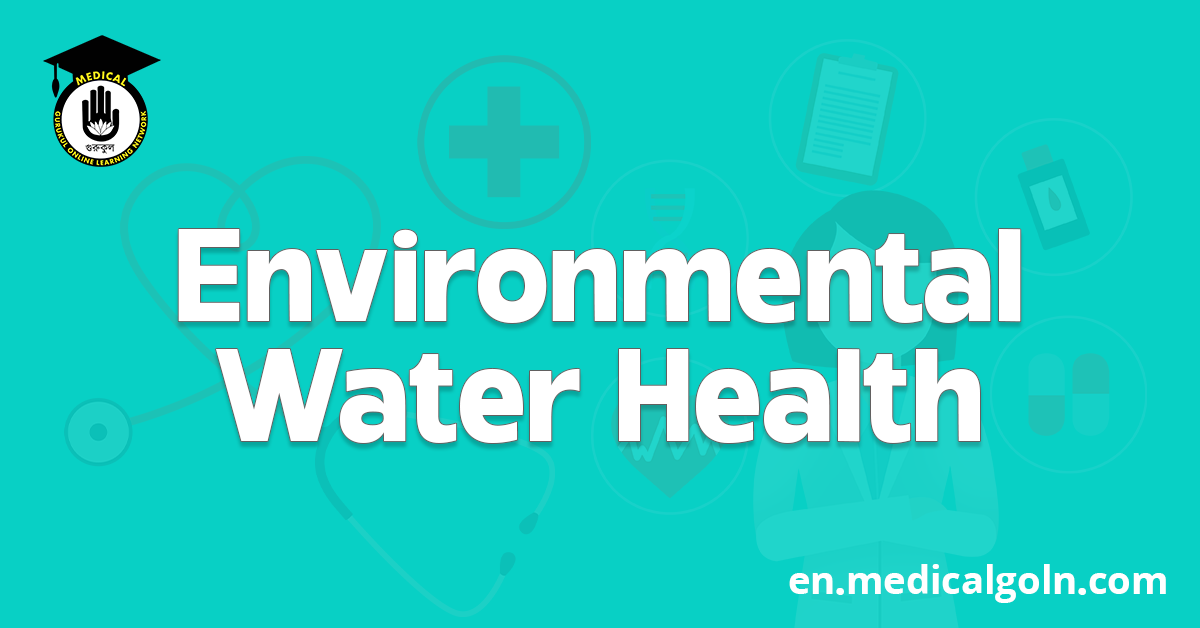Today is our topic of discussion Environmental Water Health
Environmental Water Health

Much of the ill-health which affects humanity, especially in the developing country like Bangladesh, can be traced to lack of safe and wholesome water supply. Provision of safe drinking water is one of the elements of PHC. So, water intended for human consumption should be both ‘safe’ and ‘wholesome’.
‘Safe’ and ‘wholesome’/’pure’ water:
The water is said to be ‘safe’ and ‘wholesome’/’pure’ if it fulfils the following criteria. Water is said to be ‘polluted’ or ‘contaminated’ when it does not fulfil
these criteria
1. Free from pathogenic agents.
2. Free from harmful chemical substances. 3. Pleasant to taste, i.e., free from colour and odour.
4. Usable for domestic purposes.
Types of water:
A. According to purity:
1. Pure water
2. Impure water: It is two types –
a. Polluted water: It impairs the physical properties of water.
b. Contaminated: It contains microbes of diseases or poisonous chemicals.
B. According to chemical nature:
1. Hard water tamash
2. Soft water
Hardness of water:
‘Hardness of water’ is defined as the soap-destroying power of water due to the presence of minerals as solution in water.
Hard water does not form lather with soap easily whereas soft water forms lather with soap readily. It
is unsuitable for cooking, washing and some industrial purposes. Hard water may also cause dyspepsia.
Hard water:
Water that contains mineral salts (as calcium and magnesium ions) that limit the formation of lather with soap.
Soft water:
Water that is not hard (contains no mineral salts that interfere with formation of lather with soap).

Sources of water in rural Bangladesh:
1. Rain water
2. Surface water:
a. Streams, canals, rivers, ponds, lake and sea water
b. Tanks
c. Impounding reservoirs
Rain water:
It is the safest water in nature. It is ‘soft water’ and is suitable for drinking, cooking, washing and bathing. During rainy season, it can be collected by a device from the roof of the house after a shower when the atmospheric impurities settle down.
River water:
River a common source of water supply in Bangladesh. It becomes more or less polluted from sewage, manure from fields, industrial effluents and refuse from factories. So, it is unsafe for drinking purposes and should be purified before drinking.
Impounding reservoirs:
There are artificial lakes, where surface water is stored. The area draining into the reservoir is called catchment area. Water quality is fairly good. However, there is possibility of contamination from human beings and animal excreta. So, the water needs purification before using for drinking purposes.
Tanks:
These are large excavations in which surface water is stored. There are chances of contamination and are dangerous as a source of drinking water without boiling. The quality of tank water may be considerably improved by the following ways-
a. The edge of the tank should be elevated in order to prevent the entry of surface washing.
b. No one should be permitted to get into the tank directly.
c. There should be an elevated platform from where people can draw water.

d. The weeds should be periodically removed.
e. It should be cleaned at the end of the dry season.
Springs:
When ground water come to surface and flows freely under natural pressure is called ‘spring’.
See also :
